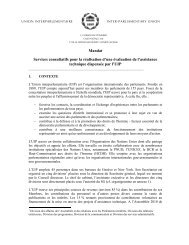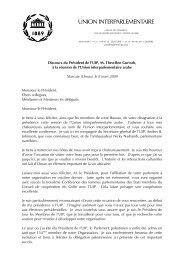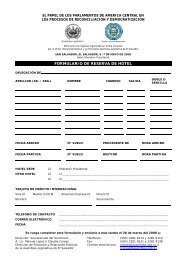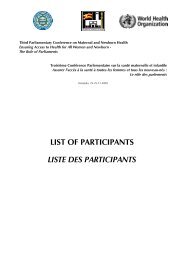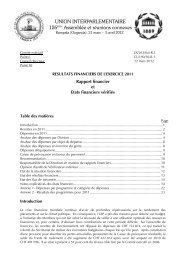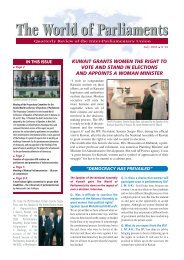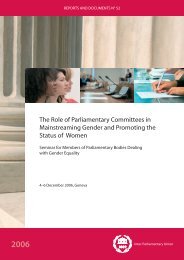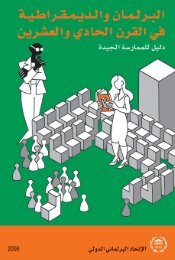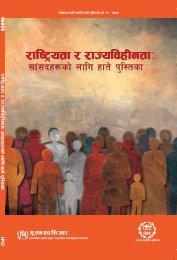MISSING PIECES - Inter-Parliamentary Union
MISSING PIECES - Inter-Parliamentary Union
MISSING PIECES - Inter-Parliamentary Union
You also want an ePaper? Increase the reach of your titles
YUMPU automatically turns print PDFs into web optimized ePapers that Google loves.
<strong>MISSING</strong> <strong>PIECES</strong><br />
as part of a rite of passage from boyhood into manhood. Guns may also<br />
be positively associated with manhood in contexts where their use was<br />
valued and encouraged as part of a widely supported liberation movement,<br />
such as the AK-47 as a symbol of the anti-apartheid struggle in South<br />
Africa. 14 Even in peacetime, boys may be socialised into a familiarity and<br />
fascination with guns, or gun-like toys. 15 In the US, where boys are the most<br />
frequent victims of accidental shootings, studies show they neither learn<br />
to distinguish toy guns from real ones, nor can resist touching a gun if they<br />
find it by accident. 16 Research among young men involved in organised<br />
armed violence in ten countries finds that carrying guns is seen as an<br />
effective means of gaining status and respect. 17 Soldiers, snipers, other gun<br />
users, and armed male role models in television, film, and violent computer<br />
games are often cult heroes, with guns routinely glorified in the<br />
popular media. 18<br />
Men dominate both the formal security sectors of states, such as the<br />
military and police, as well as non-state armed groups, gangs, and militias.<br />
19 It is also important to think about which men are most vulnerable to<br />
taking up arms. It is usually poor, marginalised men who take up badly<br />
paid and unprotected jobs in the informal security sector, 20 end up in<br />
armed gangs, and are recruited or volunteer to fight wars. From Boston<br />
to Bangkok, men are using guns ‘in order to prove their masculinity, or<br />
to defend their masculine honour, or to challenge others’. 21<br />
In wartime, many men make significant efforts to stay out of the fighting<br />
and go to great lengths to protect their families. The number of combatants<br />
and people involved in violence has in fact been relatively low in<br />
recent conflicts. Even in settings where gang involvement by young people<br />
may be prevalent, the vast majority of young men do not participate in<br />
gang activities, and when interviewed, most young men in these settings<br />
say that they fear gangs and gang-related violence. 22 It is important to<br />
understand why and how large numbers of young men do not use arms<br />
and violence, and actively oppose such violence.<br />
A number of promising programmes are being implemented to shift<br />
rigid and sometimes violent attitudes about being a man. ‘Men As Partners’<br />
in South Africa 23 works in collaboration with the military, unions, and<br />
schools to engage men in alternative views about manhood, as does the<br />
Conscientizing Male Adolescents’ project in Nigeria and the ‘Program H’<br />
initiative in Latin America and India 24 . Another striking example is the<br />
‘White Ribbon Campaign’ 25 , started in Canada in the early 1990s after a<br />
man who had not been accepted into a graduate programme in Montreal<br />
84




